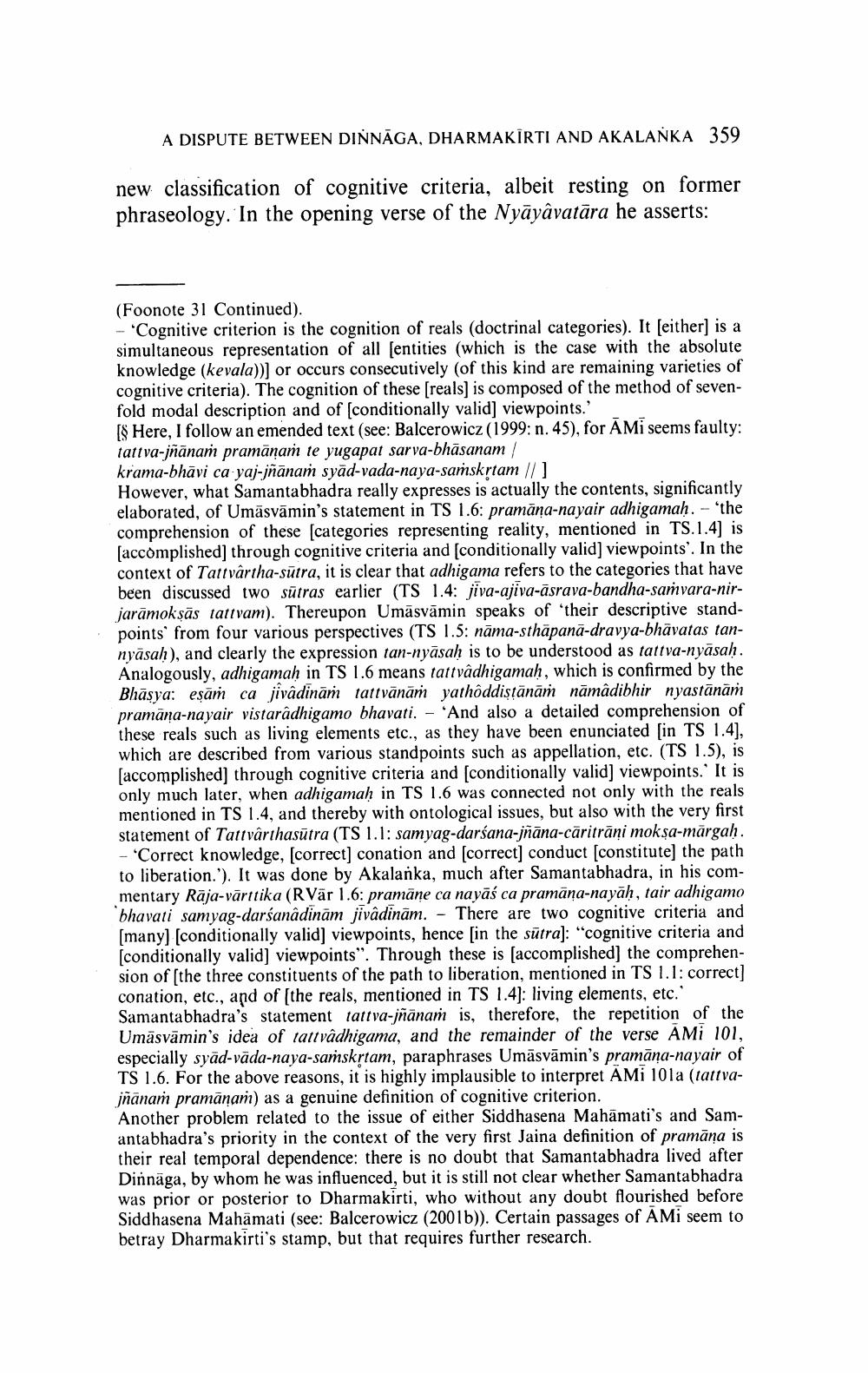________________
A DISPUTE BETWEEN DINNAGA, DHARMAKIRTI AND AKALANKA 359
new classification of cognitive criteria, albeit resting on former phraseology. In the opening verse of the Nyayâvatāra he asserts:
(Foonote 31 Continued).
- 'Cognitive criterion is the cognition of reals (doctrinal categories). It [either] is a simultaneous representation of all [entities (which is the case with the absolute knowledge (kevala))] or occurs consecutively (of this kind are remaining varieties of cognitive criteria). The cognition of these [reals] is composed of the method of sevenfold modal description and of [conditionally valid] viewpoints.'
[§ Here, I follow an emended text (see: Balcerowicz (1999: n. 45), for AMi seems faulty: tattva-jñānam pramanam te yugapat sarva-bhāsanam
krama-bhavi ca yaj-jñānam syad-vada-naya-samskṛtam ||]
However, what Samantabhadra really expresses is actually the contents, significantly elaborated, of Umäsvamin's statement in TS 1.6: pramana-nayair adhigamah. - 'the comprehension of these [categories representing reality, mentioned in TS.1.4] is [accomplished] through cognitive criteria and [conditionally valid] viewpoints'. In the context of Tattvartha-sutra, it is clear that adhigama refers to the categories that have been discussed two sutras earlier (TS 1.4: jiva-ajiva-asrava-bandha-samvara-nirjarāmokṣās tattvam). Thereupon Umāsvamin speaks of 'their descriptive standpoints from four various perspectives (TS 1.5: nama-sthāpanā-dravya-bhāvatas tannyasah), and clearly the expression tan-nyasah is to be understood as tattva-nyasaḥ. Analogously, adhigamah in TS 1.6 means tattvâdhigamaḥ, which is confirmed by the Bhāṣya: eṣam ca jivâdinām tattvänäṁ yathôddiṣṭānām nāmâdibhir nyastānām pramana-nayair vistarâdhigamo bhavati. - 'And also a detailed comprehension of these reals such as living elements etc., as they have been enunciated [in TS 1.4], which are described from various standpoints such as appellation, etc. (TS 1.5), is [accomplished] through cognitive criteria and [conditionally valid] viewpoints. It is only much later, when adhigamah in TS 1.6 was connected not only with the reals mentioned in TS 1.4, and thereby with ontological issues, but also with the very first statement of Tattvârthasutra (TS 1.1: samyag-darśana-jñāna-cāritrāni mokṣa-mārgaḥ. - 'Correct knowledge, [correct] conation and [correct] conduct [constitute] the path to liberation."). It was done by Akalanka, much after Samantabhadra, in his commentary Rāja-vārttika (RVār 1.6: pramane ca nayaś ca pramana-nayaḥ, tair adhigamo bhavati samyag-darśanâdinām jivâdinām. - There are two cognitive criteria and [many] [conditionally valid] viewpoints, hence [in the sutra]: "cognitive criteria and [conditionally valid] viewpoints". Through these is [accomplished] the comprehension of [the three constituents of the path to liberation, mentioned in TS 1.1: correct] conation, etc., and of [the reals, mentioned in TS 1.4]: living elements, etc.' Samantabhadra's statement tattva-jñānam is, therefore, the repetition of the Umäsvamin's idea of tattvâdhigama, and the remainder of the verse AMi 101, especially syad-vada-naya-samskṛtam, paraphrases Umāsvamin's pramana-nayair of TS 1.6. For the above reasons, it is highly implausible to interpret AMi 101a (tattvajñānam pramānam) as a genuine definition of cognitive criterion.
Another problem related to the issue of either Siddhasena Mahamati's and Samantabhadra's priority in the context of the very first Jaina definition of pramāņa is their real temporal dependence: there is no doubt that Samantabhadra lived after Dinnaga, by whom he was influenced, but it is still not clear whether Samantabhadra was prior or posterior to Dharmakirti, who without any doubt flourished before Siddhasena Mahämati (see: Balcerowicz (2001b)). Certain passages of AMi seem to betray Dharmakirti's stamp, but that requires further research.




